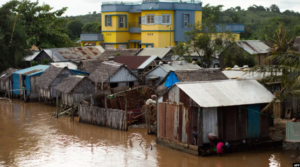Trapped?: Those Who Stay Put During Natural Hazards

Credit: Elie Sergio / AFP
02 May 2024
According to IOM, the recent cyclone in Madagascar, a country “highly exposed to natural hazards [that] ranks among the top 10 of countries most vulnerable to climate change globally,” had devastating effects for an estimated 220,000 people who need immediate humanitarian aid.
However, as the UN Office for the Coordination for Humanitarian Affairs (OCHA) notes, emergency response is difficult because the region that was affected is a three day trip from the capital, Antananarivo, “and the road connecting the capital to the north-east region is currently cut-off due to the rains.” Furthermore, an Al Jazeera article highlights that there is still not enough knowledge about the extent of the damage because “many villages in the region were cut off from the rest of the country, making access difficult for rescue teams.” Unfortunately, this is not the first time a natural disaster has had large-scale effects in Madagascar. Just a year ago, Cyclone Freddy – the longest-ever recorded cyclone in history – left over 500 people dead across Malawi, Mozambique, and Madagascar.
‘Immobility Paradox’
In countries like Madagascar that suffer from frequent natural hazards, populations are being hit again and again… and again. The plethora of research, policy briefs, news headlines, and statistics aiming to capture the scale of internal displacement due to climate-related events are not painting a full picture, though. In fact, Caroline Zickgraf, an expert on the topic, writes that “the vast majority of people living in places highly vulnerable to climate change do not migrate… the relationship between migration and climate change is non-linear… some individuals can adapt in place, while many people do not have the capability to move, and others might be able to but are reluctant to leave homelands to which they feel irrevocably bound… when migration is not a viable option, people who are unable or unwilling to move may be the ones most negatively affected by climate change, as they become trapped in increasingly uninhabitable locations.”
In what has been deemed the ‘immobility paradox’–“large swatches of land across the world become increasingly inhabitable, [but] few people migrate from those countries most affected by climate change” – in academic literature may seem like a puzzling phenomenon at first glance. However, it is actually in line with what migration scholars like Hein de Haas have been describing for many years: resources are needed to migrate, hence those who are able to migrate are usually not among the most impoverished. In reality, there are also a host of reasons why people do not leave. These can range from economic hardship to a deep sense of belonging to their homes. People have to make quick decisions based on the information they have on hand and considering their specific situation/reality. The truth is that there is no ‘right’ or ‘wrong’ decision.
That being said, it is important to draw a distinction between those who choose to stay and those who have no other choice. It is a blurred line that needs to be better understood because ‘trapped populations’ – “people who not only aspire but also need to move for their own protection but who nevertheless lack the ability” – suffer the worst consequences of sudden onset disasters. As explained by Maxine Alleyne & Hélène Glenisson, people who are ‘trapped’ when a cyclone, flood, or hurricane occur are “among the most vulnerable because they are unable to escape the impacts of climate disasters and often do not have the resources to build resilience as they face poverty, health issues, and food insecurity among others… inequalities related to gender, age and disability also influence the capacity to move or not in the wake of risks.”
Further evidence published by Future Earth, The Earth League, and the World Climate Research Programme (WCRP) shows that “climate change can increase barriers to mobility, leading to a rise in immobility particularly among the poorest populations.” Human Rights Watch (HRW) has research demonstrating that “people with disabilities and older people faced greater issues accessing warnings and emergency information, as well as reaching humanitarian support in the aftermath.” As part of this research, HRW conducted interviews in northeastern Bangladesh. Mohammed Montaz shared that Taslima, his twenty-year-old daughter with multiple disabilities, died in a flood. Taslima swallowed a lot of dirty water and was in and out of consciousness. They were unable to secure the necessary funds or a boat to get her to a hospital to get proper treatment. Ten days later, Taslima died.
Initiatives
The global attention being paid to (im)mobility, especially within the context of climate change is at an all time high. This momentum should be taken advantage of to adopt overdue agreements and initiatives adopting an intersectional lens to address root causes of climate (im)mobility. At COP28, there was a historic agreement which operationalized the Loss and Damage Fund and included displacement and displaced persons within it. According to the Internal Displacement Monitoring Centre (IDMC), “this will allow the Fund to provide finance to support vulnerable developing countries to implement measures and policies related to displacement, including by enhancing evidence and addressing data gaps.”
However, solely focusing on mobility ignores a large segment of the population who ends up staying, whether that is by choice or a mere consequence of a lack of alternative options. A recent report argues that the current “governance of climate immobility is fragmented at best, with only some policy hints or guidance arising either within human rights frameworks, within disaster risk reduction (DRR) frameworks, or within climate mobility policy.” The World Bank Group’s research on the (im)mobility outcomes of Nigerian farming households in relation to climate shocks suggests “targeted measures and group-specific and adaptation policies able to tackle the complex challenges stemming from climate-mobility interactions at multiple levels.” This could include working with local communities to develop accessible information campaigns, emergency response centers/routes, and climate resilience ahead of future environmental threats.

 Itziri Gonzalez Barcenas
Itziri Gonzalez Barcenas
